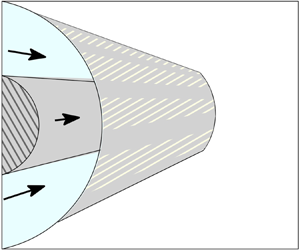Crossref Citations
This article has been cited by the following publications. This list is generated based on data provided by
Crossref.
Ren, Liuzhen
Hu, Haibao
Bao, Luyao
Zhang, Mengzhuo
Wen, Jun
and
Xie, Luo
2021.
Many-body dissipative particle dynamics study of the local slippage over superhydrophobic surfaces.
Physics of Fluids,
Vol. 33,
Issue. 7,
Ren, Liuzhen
Hu, Haibao
Bao, Luyao
Priezjev, Nikolai V.
Wen, Jun
and
Xie, Luo
2022.
Two local slip modes at the liquid–liquid interface over liquid-infused surfaces.
Physics of Fluids,
Vol. 34,
Issue. 8,
Zigelman, Anna
Mansfield, Ariella
and
Gat, Amir D.
2022.
Effect of the Cassie state in grooved channels on one-dimensional sound waves.
Physical Review Fluids,
Vol. 7,
Issue. 6,
Rodriguez-Broadbent, Henry
and
Crowdy, Darren G
2022.
Superhydrophobicity Can Enhance Convective Heat Transfer in Pressure-Driven Pipe Flow.
The Quarterly Journal of Mechanics and Applied Mathematics,
Vol. 75,
Issue. 4,
p.
315.
Ren, Junjie
Wang, Shengzhen
Wu, Qingxing
and
Song, Yinan
2023.
Axisymmetric lattice Boltzmann model for liquid flows with super-hydrophobic cylindrical surfaces.
European Journal of Mechanics - B/Fluids,
Vol. 98,
Issue. ,
p.
120.
Zhou, Zeyu
Liao, Bokai
and
Guo, Xingpeng
2023.
Numerical simulation of heat and mass transfer in heat exchange tubes based on action of interfacial slip.
International Communications in Heat and Mass Transfer,
Vol. 146,
Issue. ,
p.
106929.
Joulaei, A.
Rahmani, H.
and
Taghavi, S. M.
2024.
Effects of wall groove misalignment on viscoplastic flow dynamics in superhydrophobic channels.
Physical Review Fluids,
Vol. 9,
Issue. 12,
Crowdy, Darren G.
2024.
Torque-driven superhydrophobic cylinders swim in circles.
Proceedings of the Royal Society A: Mathematical, Physical and Engineering Sciences,
Vol. 480,
Issue. 2300,
Zimmermann, Sebastian
and
Schönecker, Clarissa
2024.
Analytical models for pressure-driven Stokes flow through superhydrophobic and liquid-infused tubes and annular pipes.
Journal of Fluid Mechanics,
Vol. 978,
Issue. ,
Berti, Zavier
and
Flynn, M. R.
2024.
A Nusselt number correlation for a superhydrophobic solid sphere encapsulated in a perfect plastron.
Journal of Engineering Mathematics,
Vol. 147,
Issue. 1,
Lobasov, Alexander S.
Rudyak, Valery Ya.
and
Minakov, Andrey V.
2024.
Investigation of the slip boundary conditions effect on the flow regimes, mixing efficiency and heat transfer in a T-type micromixer.
Chemical Engineering and Processing - Process Intensification,
Vol. 198,
Issue. ,
p.
109726.
Zimmermann, Sebastian
Bold, Ellen
Oesterschulze, Egbert
Chijiwa, Munehiro
Schäfer, Mareike
L'huillier, Johannes
and
Schönecker, Clarissa
2024.
Modeling flow through tubes and annuli with liquid‐infused surfaces for enhanced stability of the fluid‐fluid interface.
PAMM,
Vol. 24,
Issue. 1,
Miyoshi, Hiroyuki
Rodriguez-Broadbent, Henry
and
Crowdy, Darren G.
2024.
Numerical validation of analytical formulas for channel flows over liquid-infused surfaces.
Journal of Engineering Mathematics,
Vol. 144,
Issue. 1,
Ren, Liuzhen
Zhang, Mengzhuo
Hu, Haibao
Wen, Jun
and
Xie, Luo
2024.
Transition of slip mode at gas–liquid interface formed by wettability steps on an superhydrophobic surface.
Ocean Engineering,
Vol. 294,
Issue. ,
p.
116823.
Rahmani, Hossein
Larachi, Faïçal
and
Taghavi, Seyed Mohammad
2024.
Modeling of Shear Flows over Superhydrophobic Surfaces: From Newtonian to Non-Newtonian Fluids.
ACS Engineering Au,
Vol. 4,
Issue. 2,
p.
166.
Joulaei, A.
Rahmani, H.
and
Taghavi, S.M.
2025.
Control of viscoplastic fluid dynamics in superhydrophobic channels with asymmetric groove configurations.
Journal of Non-Newtonian Fluid Mechanics,
Vol. 341,
Issue. ,
p.
105420.
Joulaei, A.
Pal, A.
Rahmani, H.
and
Taghavi, S. M.
2025.
Deep learning-assisted prediction of viscoplastic flow in superhydrophobic channels.
Physics of Fluids,
Vol. 37,
Issue. 5,
Zimmermann, Sebastian
Schönecker, Clarissa
and
Crowdy, Darren G.
2025.
Pressure-driven flow through superhydrophobic pipes with general patterns of longitudinal no-shear stripes.
Journal of Fluid Mechanics,
Vol. 1009,
Issue. ,
